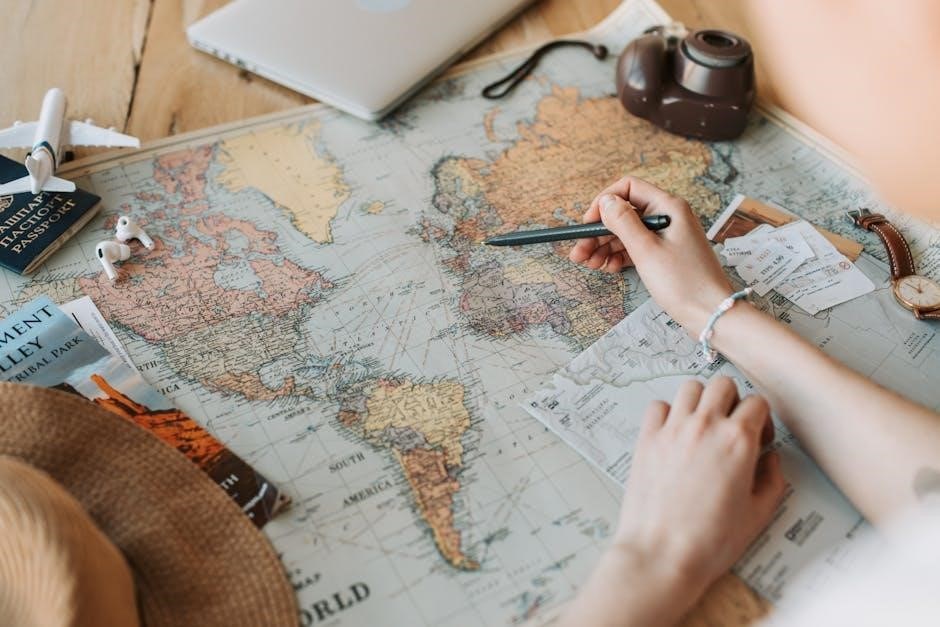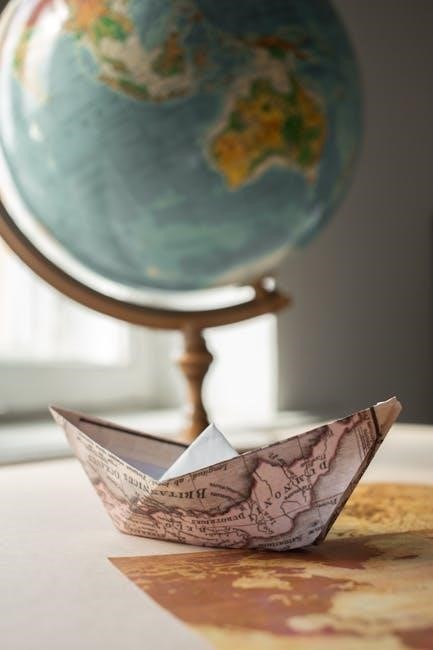
This unit explores the transformative connections between the Eastern and Western Hemispheres from 1450 to 1750‚ focusing on technological‚ cultural‚ and economic developments that shaped global history.
Transoceanic interconnections‚ spanning from 1450 to 1750‚ marked a pivotal era of global transformation. This period saw the rise of maritime exploration‚ the establishment of trade networks‚ and the exchange of cultures‚ ideas‚ and resources. European explorers like Columbus and Vasco da Gama pioneered new sea routes‚ while Asian and African societies played crucial roles in shaping these connections. The Columbian Exchange‚ technological advancements‚ and the expansion of empires reshaped economies and societies worldwide. This unit examines how these interactions fostered cultural blending‚ economic growth‚ and the emergence of a more interconnected world‚ laying the foundation for modern globalization and its far-reaching impacts.
Key Themes and Concepts
Central to this unit are themes of exploration‚ trade‚ and cultural exchange. Technological innovations‚ such as the caravel and astrolabe‚ enabled transoceanic voyages. The Columbian Exchange transferred plants‚ animals‚ and diseases between hemispheres‚ profoundly impacting populations. Empires like Portugal‚ Spain‚ and later the Dutch and English‚ sought control over resources and markets. Mercantilism and the triangular trade system shaped economies‚ while the spread of religions and syncretism influenced cultures. The decline of indigenous and Asian emires‚ alongside the rise of European dominance‚ highlights the era’s transformative and often disruptive nature‚ setting the stage for global interconnectedness and modern world systems.
2.1 Technological Innovations (1450-1750)
Advances like the caravel‚ carrack‚ and fluyt revolutionized maritime trade‚ enabling longer voyages and efficient cargo transport‚ while improved navigation tools like the astrolabe enhanced exploration accuracy.
2.1.1 Development of the Caravel and Carrack
The caravel and carrack were pivotal maritime innovations during the Age of Exploration. The caravel‚ a smaller‚ agile ship‚ featured lateen sails‚ allowing for better maneuverability and navigation in various winds. Its streamlined design made it ideal for oceanic voyages‚ enabling explorers like Columbus and da Gama to traverse vast distances. The carrack‚ larger and sturdier‚ was designed for cargo and long-distance trade‚ incorporating multiple masts and square sails for efficiency. These vessels facilitated European exploration and trade‚ connecting distant regions and laying the groundwork for global interconnections. Their development marked a significant leap in naval technology‚ enabling the exploration and exploitation of new territories and resources.
2.1.2 Advances in Navigation Tools
Advances in navigation tools were crucial for transoceanic exploration. The astrolabe‚ a device measuring celestial bodies’ positions‚ became more precise‚ aiding sailors in determining latitude. The compass‚ though existing earlier‚ saw improved designs‚ providing reliable directional guidance. The sextant emerged later‚ enhancing accuracy in celestial navigation. Charts and maps became more detailed‚ incorporating new discoveries. These innovations‚ alongside the development of the caravel and carrack‚ revolutionized maritime travel‚ enabling explorers to venture further with greater confidence. Such technological progress was essential for the successful navigation of unknown waters and the establishment of global trade routes during this period.
2.1.3 The Role of the Fluyt in Maritime Trade
The fluyt‚ a Dutch cargo ship‚ played a pivotal role in maritime trade during the 17th century. Its streamlined design and large cargo capacity made it highly efficient for transporting goods. The fluyt was primarily used in the Baltic and North Sea trade‚ facilitating the exchange of grain‚ timber‚ and other commodities. Its fuel efficiency allowed for longer voyages with smaller crews‚ reducing costs and increasing profitability. This ship design contributed significantly to the Dutch dominance of global trade‚ enabling the Netherlands to become a major economic power during its Golden Age. The fluyt’s impact on maritime trade was instrumental in shaping the global economy of the time.

2.2 Major Explorers and Their Voyages
European explorers like Columbus‚ Vasco da Gama‚ and Magellan transformed global connections through their voyages‚ establishing new trade routes and fostering cultural exchanges between the East and West.
2.2.1 European Explorers: Columbus‚ Vasco da Gama‚ Magellan
Christopher Columbus‚ sponsored by Spain‚ famously reached the Americas in 1492‚ initiating European exploration of the New World. Vasco da Gama established a sea route to India in 1498‚ securing Portugal’s dominance in the spice trade. Ferdinand Magellan led the first circumnavigation of the globe‚ proving the Earth’s roundness and opening the Pacific to European exploration. These voyages reshaped global trade‚ cultural exchanges‚ and geopolitical power‚ laying the foundation for European empires and the Columbian Exchange. Their journeys marked the beginning of a new era of transoceanic interconnections‚ forever altering the world’s economic and cultural landscapes.
2.2.2 Asian Explorers: Zheng He and Maritime Expeditions
Zheng He‚ a Chinese admiral‚ led seven maritime expeditions between 1405 and 1433 under the Ming Dynasty. Commanding a vast fleet of treasure ships‚ he visited Southeast Asia‚ India‚ the Middle East‚ and East Africa‚ fostering diplomatic and cultural ties. Unlike European explorers‚ Zheng He’s voyages focused on peaceful exchange rather than conquest. His journeys showcased China’s advanced naval technology and promoted trade‚ spreading Chinese culture and goods. However‚ after his death‚ China halted further maritime exploration‚ shifting focus inward. Zheng He’s expeditions remain a testament to China’s historical maritime prowess and its early role in global interconnectedness‚ leaving a lasting legacy in the regions he explored.
2.2.3 African and American Explorers: Indigenous Contributions
Indigenous explorers from Africa and the Americas played crucial roles in shaping transoceanic interconnections. African navigators and traders established vast networks across the Sahara and coastal regions‚ facilitating the exchange of goods and ideas. In the Americas‚ Native American groups possessed deep knowledge of local geography and resources‚ aiding European explorers in navigation and settlement. While their contributions were often overshadowed by European narratives‚ indigenous peoples were integral to the exploration and trade systems. Their expertise in local environments and existing trade routes proved essential for European success. However‚ the arrival of Europeans disrupted these systems‚ leading to significant social and economic changes for indigenous populations. Their legacy remains vital in understanding the global interconnectedness of the time.

2.3 Transoceanic Trade Networks
Transoceanic trade networks connected Europe‚ Asia‚ Africa‚ and the Americas‚ facilitating the exchange of goods‚ ideas‚ and cultures. These systems‚ including the Triangular Trade and Silk Road‚ shaped global economies and cultural exchange‚ while also fostering the spread of diseases and exploitation‚ profoundly impacting societies worldwide.
2.3.1 The Establishment of the Triangular Trade System
The Triangular Trade System linked Europe‚ Africa‚ and the Americas‚ driven by European powers like Portugal‚ Spain‚ Britain‚ France‚ and the Netherlands. This system revolved around the exchange of goods such as sugar‚ tobacco‚ and enslaved Africans. European manufactured goods were traded in Africa for enslaved people‚ who were then transported to the Americas to work on plantations producing raw materials. These materials were shipped back to Europe‚ completing the triangle. The system fueled economic growth in Europe and the Americas but had devastating social and demographic impacts‚ particularly in Africa. It also laid the foundation for global mercantilist economies and reinforced racial hierarchies that persisted for centuries.
2.3.2 The Role of the Silk Road and Spice Routes
The Silk Road and Spice Routes were ancient networks connecting Europe‚ Asia‚ and Africa‚ facilitating the exchange of goods‚ ideas‚ and cultures. The Silk Road‚ established during the Han Dynasty‚ linked China with the Mediterranean‚ while the Spice Routes‚ dominated by Arab and Indian traders‚ focused on spices like pepper and cinnamon. These networks declined with the rise of transoceanic trade but influenced later European explorers seeking new maritime routes. They laid the groundwork for global trade systems by establishing patterns of exchange and cultural interaction that persisted into the early modern period‚ shaping the economic and cultural foundations of civilizations worldwide.
2.3.3 The Impact of the Columbian Exchange
The Columbian Exchange‚ sparked by Christopher Columbus’s voyages‚ was a vast transfer of plants‚ animals‚ diseases‚ and cultures between the Americas and Afro-Eurasia. Crops like maize‚ potatoes‚ and cassava transformed agriculture in Europe‚ Africa‚ and Asia‚ boosting populations. In return‚ Europeans introduced horses‚ cattle‚ and wheat to the Americas‚ reshaping local ecosystems. However‚ the exchange also brought devastating diseases‚ such as smallpox‚ which decimated indigenous populations lacking immunity. This biological and cultural exchange profoundly altered global demographics‚ economies‚ and societies‚ creating lasting legacies in food systems‚ environmental landscapes‚ and social structures that continue to influence the modern world.
2.4 The Columbian Exchange
The Columbian Exchange‚ following Columbus’s voyages‚ transferred plants‚ animals‚ diseases‚ and cultures between the Americas and Afro-Eurasia‚ profoundly impacting demographics‚ economies‚ and societies globally.
2.4.1 Definition and Historical Context
The Columbian Exchange was the widespread transfer of plants‚ animals‚ diseases‚ and cultures between the Americas and Afro-Eurasia following Christopher Columbus’s voyages in 1492. This exchange occurred as European explorers established trade routes and colonies‚ leading to the movement of goods‚ ideas‚ and people across the Atlantic. It marked a significant turning point in global history‚ reshaping ecosystems‚ economies‚ and societies. The exchange introduced horses‚ wheat‚ and diseases like smallpox to the Americas‚ while maize‚ potatoes‚ and cacao spread to Europe‚ Africa‚ and Asia. This process had profound and far-reaching consequences‚ altering demographics and cultures forever.
2.4.2 The Exchange of Plants‚ Animals‚ and Diseases
The Columbian Exchange facilitated the transfer of plants‚ animals‚ and diseases between the Americas and Afro-Eurasia. Crops like maize‚ potatoes‚ and cassava were introduced to Europe‚ Africa‚ and Asia‚ boosting food production and population growth. In return‚ Europeans brought wheat‚ sugarcane‚ and livestock such as horses and cattle to the Americas. Diseases like smallpox and influenza‚ to which indigenous populations had no immunity‚ spread rapidly‚ causing devastating epidemics. This biological exchange reshaped ecosystems‚ economies‚ and societies‚ creating both opportunities and challenges for cultures on both sides of the Atlantic. The impact of these exchanges remains evident in modern agriculture and demographics.
2.4.3 The Long-Term Effects on Global Populations
The Columbian Exchange had profound demographic consequences. In the Americas‚ indigenous populations declined sharply due to diseases like smallpox and influenza‚ to which they had no immunity. This led to labor shortages‚ disrupting societies and economies. In contrast‚ Eurasia and Africa experienced population growth‚ benefiting from the introduction of crops like maize and potatoes‚ which increased food production. The exchange also spurred migration and the transatlantic slave trade‚ reshaping the racial and cultural composition of the Americas. Over time‚ these changes influenced global power dynamics‚ economic systems‚ and cultural identities‚ leaving a lasting legacy in modern societies. The demographic shifts remain a critical aspect of understanding this period.

2.5 Religious and Cultural Interactions
Religious and cultural exchanges flourished during this period‚ with Christianity and Islam spreading widely. Missionaries played key roles in cultural exchange‚ while syncretism blended local and foreign traditions‚ reshaping identities globally.
2.5.1 The Spread of Christianity and Islam
During the transoceanic interconnections period‚ Christianity and Islam spread extensively through exploration‚ trade‚ and missionary work. European explorers and colonizers introduced Christianity to the Americas and Asia‚ often aligning with imperial goals. Missionaries adapted local practices to attract converts‚ blending religious traditions. Islam expanded through African and Asian trade networks‚ with Muslim merchants and Sufi mystics spreading the faith. The Spice Routes and Silk Road facilitated Islamic cultural exchange‚ particularly in Southeast Asia and Africa. Both religions integrated into local cultures‚ creating syncretic practices that endured. This period marked a significant era of religious diffusion‚ shaping global cultural and spiritual landscapes for centuries to come.
2.5.2 The Role of Missionaries in Cultural Exchange
Missionaries played a pivotal role in cultural exchange during the transoceanic interconnections period. European missionaries‚ particularly from Catholic orders like the Jesuits‚ traveled extensively‚ spreading Christianity while engaging with local cultures. They adapted religious practices to indigenous traditions‚ fostering syncretism. Missionaries also introduced Western education‚ medicine‚ and technologies‚ influencing local societies. Conversely‚ they learned from and documented local customs‚ languages‚ and knowledge systems‚ facilitating cultural exchange. Islamic scholars and Sufis similarly bridged cultural gaps through trade and spiritual teachings. Missionaries served as intermediaries‚ enabling the transfer of ideas and practices between East and West‚ while often advancing colonial agendas. Their efforts left lasting impacts on global cultural diversity and understanding.
2.5.3 The Impact of Syncretism on Local Cultures
Syncretism‚ the blending of different cultural and religious practices‚ profoundly impacted local cultures during transoceanic interconnections. It led to the creation of new cultural forms‚ such as the fusion of indigenous and European traditions in Latin America. This blending often resulted in unique religious practices‚ art‚ and social structures. While syncretism fostered cultural adaptation and resilience‚ it also sometimes eroded traditional practices. Missionaries and colonizers often encouraged syncretism to ease conversion‚ but it also allowed local populations to retain elements of their identity. Over time‚ syncretism shaped the cultural diversity of regions like Africa‚ Asia‚ and the Americas‚ leaving a lasting legacy in global cultural landscapes.

2.6 The Role of Empires in Transoceanic Interconnections
European empires such as Portugal‚ Spain‚ the Dutch‚ and England established vast trade networks‚ colonies‚ and military outposts‚ shaping global economies and political landscapes through their dominance.
2.6.1 The Portuguese Empire and the Spice Trade
The Portuguese Empire played a pivotal role in establishing transoceanic trade networks‚ particularly in the spice trade. By controlling key maritime routes and colonies in Asia‚ such as Goa‚ Malacca‚ and Ormuz‚ Portugal dominated the flow of spices like pepper and cinnamon to Europe. The development of the caravel enabled Portuguese explorers to navigate vast oceans efficiently. This dominance challenged existing Venetian and Arab trade monopolies‚ redirecting spice routes to favor European markets. The wealth generated from this trade bolstered Portugal’s economy and influence but also attracted rivalry from emerging powers like the Dutch and English‚ who sought to disrupt Portuguese control over these lucrative trade systems.
2.6.2 The Spanish Empire and the Conquest of the Americas
The Spanish Empire’s conquest of the Americas‚ beginning with Columbus’s voyages‚ reshaped global history. Spanish explorers like Hernán Cortés and Francisco Pizarro conquered the Aztec and Inca empires‚ exploiting their resources and labor. The Spanish established colonies‚ spreading Christianity and imposing European governance. The Columbian Exchange flourished‚ transferring plants‚ animals‚ and cultures between hemispheres. However‚ indigenous populations suffered severely from diseases‚ forced labor‚ and violence‚ leading to significant population decline. The Spanish Empire’s dominance in the Americas laid the foundation for its wealth and influence‚ while also setting the stage for long-term social and economic transformations in the region and beyond. This period marked the beginning of European colonization in the Americas.
2.6.3 The Rise of the Dutch and English Empires
The Dutch and English empires emerged as significant powers during the 17th century‚ challenging Portuguese and Spanish dominance. The Dutch East India Company and the English East India Company played pivotal roles in establishing trade networks‚ particularly in Asia. The Dutch focused on the spice trade‚ while the English expanded their influence through colonization in North America and the Caribbean. Both nations developed strong naval capabilities‚ which enabled them to control key trade routes and establish colonies. Their rise was fueled by mercantilist policies‚ technological advancements‚ and effective organizational structures. This period marked the transition from Iberian to Northern European hegemony in global trade and colonization‚ reshaping the world economy and political landscape. Their rivalry often led to conflicts‚ but it also spurred innovation and economic growth. The establishment of these empires laid the groundwork for modern globalization.
2.7 Social and Economic Impacts
The transoceanic interconnections transformed global economies‚ creating wealth inequality‚ labor exploitation‚ and cultural exchanges that reshaped societies and laid the groundwork for modern economic systems.
2.7.1 The Effects of Transoceanic Trade on Global Economies
Transoceanic trade significantly reshaped global economies by redistributing wealth and resources. European nations‚ particularly Portugal‚ Spain‚ and later the Netherlands and England‚ amassed vast riches through colonial exploitation and trade monopolies. The establishment of the triangular trade system and the Columbian Exchange facilitated the movement of goods‚ such as sugar‚ spices‚ and precious metals‚ which fueled economic growth in Europe. However‚ this prosperity came at the expense of non-European societies‚ many of which experienced economic decline due to resource depletion and unequal trade practices. The global economy became increasingly interconnected‚ laying the foundation for modern capitalism and globalization‚ while also exacerbating inequality and dependency.
2.7.2 The Impact of Slavery and the Slave Trade
The transatlantic slave trade had a profound and devastating impact on global societies. Millions of enslaved Africans were forcibly transported to the Americas‚ fueling the economies of European colonies through labor in plantations‚ mines‚ and other industries. This system was integral to the triangular trade‚ enriching European powers while devastating African societies. The slave trade disrupted populations‚ caused cultural dislocation‚ and entrenched racial inequalities. It also led to the growth of racism and discrimination‚ which persisted long after slavery’s abolition. The economic benefits for European empires came at the cost of immense human suffering‚ shaping the modern world’s social and economic structures in lasting ways.
2.7.3 The Role of Mercantilism in Shaping Colonial Policies
Mercantilism was a dominant economic theory that shaped colonial policies during the transoceanic interconnections period. European powers‚ such as Spain‚ Portugal‚ France‚ and England‚ sought to maximize exports and minimize imports to accumulate wealth‚ particularly gold and silver. Colonies were established primarily to serve the economic interests of the mother country‚ providing raw materials and markets for manufactured goods. This led to policies like monopolies‚ navigation acts‚ and restrictive trade agreements. Mercantilism fostered competition among European nations‚ driving exploration and the establishment of colonies. However‚ it also led to exploitation of indigenous populations and resources‚ shaping the social and economic structures of both colonies and European nations for centuries.

2.8 The Decline of Asian and Indigenous Empires
The decline of Asian and Indigenous empires‚ such as the Ming Dynasty‚ Aztec‚ and Inca‚ resulted from internal instability‚ external pressures‚ and European colonization impacts.
2.8.1 The Decline of the Ming Dynasty in China

The Ming Dynasty’s decline in the 17th century was driven by internal instability‚ economic strain‚ and external pressures. Political corruption‚ eunuch influence‚ and factional strife weakened the central government. Agricultural disruptions and fiscal crises further eroded stability. The Manchu invasions from the north exploited these vulnerabilities‚ culminating in the fall of Beijing in 1644. The Ming’s rigid bureaucratic system and inability to adapt to changing circumstances hastened its collapse. This decline marked the end of native Chinese rule and paved the way for the Qing Dynasty‚ a Manchu-led empire that would shape China’s future. The Ming’s legacy includes cultural achievements‚ but its political failures remain significant.

2.8.2 The Fall of the Aztec and Inca Empires
The Aztec and Inca Empires fell due to European conquest and internal vulnerabilities. Hernán Cortés and Francisco Pizarro led Spanish forces‚ exploiting divisions and using superior weaponry. The introduction of diseases like smallpox decimated populations‚ weakening resistance. Centralized power structures made these empires vulnerable to collapse once leaders were captured or killed. Economic strain and social tensions further destabilized the empires. The Spanish exploited local alliances and rebellions to gain control. The fall of Tenochtitlán in 1521 and Cusco in 1533 marked the end of these civilizations‚ leading to European domination and profound cultural‚ political‚ and demographic changes in the Americas.
2.8;3 The Impact of European Colonization on Indigenous Peoples
European colonization had devastating effects on indigenous populations. The introduction of diseases like smallpox caused massive population declines‚ as native peoples lacked immunity. Violence‚ forced labor‚ and enslavement disrupted societies‚ while cultural practices and traditions were suppressed. Land expropriation led to loss of resources and autonomy. Resistance was met with brutal suppression‚ further marginalizing indigenous groups. The imposition of European systems erased native identities and reshaped local economies. Long-term effects included social fragmentation‚ economic dependency‚ and cultural erasure. These impacts linger‚ influencing the ongoing struggles of indigenous communities to reclaim their heritage and rights in a world shaped by colonial legacies.
2.9 The Legacy of Transoceanic Interconnections
Transoceanic interconnections reshaped global systems‚ fostering cultural exchange‚ economic interdependence‚ and the rise of globalization‚ leaving a lasting impact on modern societies and international relations.

2.9.1 The Shaping of the Modern World Order
Transoceanic interconnections laid the foundation for the modern world order by establishing global trade networks‚ fostering cultural exchange‚ and facilitating the rise of European empires. The Columbian Exchange introduced new crops‚ reshaping economies and populations worldwide. European dominance in maritime trade and colonization set the stage for the emergence of capitalism and industrialization. The decline of Asian and indigenous empires‚ coupled with the rise of global interconnectedness‚ created a new balance of power. These developments influenced political structures‚ economic systems‚ and cultural identities‚ ultimately shaping the globalized world of the 21st century. The legacy of these interconnections remains evident in modern international relations and global trade systems.
2.9.2 The Role of Globalization in the 21st Century
Globalization in the 21st century is deeply rooted in the transoceanic interconnections of the past. The establishment of global trade networks and cultural exchanges during the 1450-1750 period laid the groundwork for modern globalization. Today‚ advancements in technology and communication have accelerated the interconnectedness of economies‚ societies‚ and cultures worldwide. The legacy of historical trade systems‚ such as the triangular trade and the Columbian Exchange‚ is evident in contemporary global supply chains and the movement of goods‚ ideas‚ and people. Globalization continues to shape modern societies‚ fostering economic interdependence and cultural diversity‚ while also presenting challenges like inequality and environmental impact‚ mirroring the complexities of earlier transoceanic interactions.
2.9.3 The Continuing Impact of Historical Trade Networks
Historical trade networks established during the transoceanic interconnections period continue to influence modern global commerce and cultural exchange. The routes and systems developed by European‚ Asian‚ and African traders laid the foundation for contemporary international trade. The exchange of goods‚ ideas‚ and technologies‚ such as the Columbian Exchange‚ has evolved into complex global supply chains. Additionally‚ the cultural blending and syncretism that occurred during this era have shaped modern multicultural societies. The legacy of these networks is evident in the persistence of regional economic specializations and the enduring connections between distant regions‚ highlighting the long-term impact of early global interactions on the modern world.
